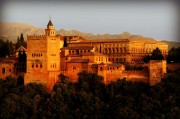A brief history of Andalusia (and the wine that is made there)
10 November 2014 by Catherine Holdsworth in Sherry, Wine and spirits
Most of you will know that sherry is made in the famous ‘sherry triangle’ in Spain, in the region of Andalusia. However, you may not know about the history of the region and the events which led to the production of sherry in such a concentrated area.
Of course, the reason sherry is produced there and nowhere else is due to the climate, the soil and the type of grape that produces the popular wine. Yet sherry is intrinsically Spanish and the perfect accompaniment to tapas. But what has happened in this region that gives sherry its character?
Firstly, Andalusia has been colonized by many different cultures, for over 6000 years, including the Greeks, Phoenicians, Romans, Jews and Muslims, bringing not only cultural but culinary diversity to this region. Its close proximity to the coast meant that major cities such as Cordoba and Granada were hotspots for migrant traders over the centuries.
Andalusia, known for a time as Al-Andalus due to the Islamic influence, was a key setting for the religious Reformation across Europe, and the infamous Spanish Inquisition. Such change has had an irreversible effect on the demographic of the area as well as the architecture, literature and artwork.
The stoic philosopher Sencea is said to have hailed from this region; clearly it has produced more than just the sherry grape.
However, it is still famous for its popular wine, which is thought to have been introduced to Britain around the time of the Spanish Armada in the 1500s. With such a long and colourful history, this region has produced one of the most distinctive wines in the world.
If you’d like to know more about the history of sherry, Julian Jeffs’ Sherry (sixth edition) will be published on 20th November and copies can be preordered now. A great read, it will make a gratefully received gift for those who are interested in history, wine – or indeed books!


